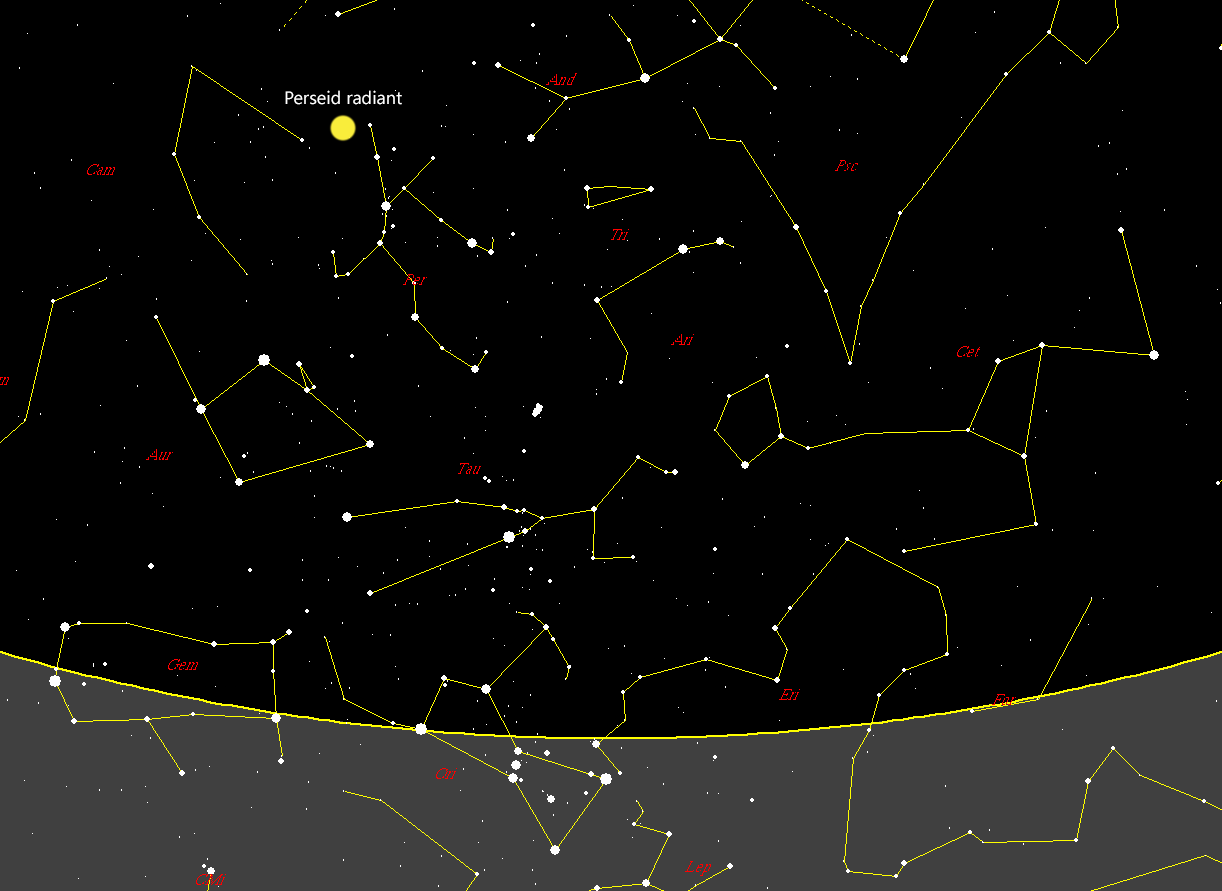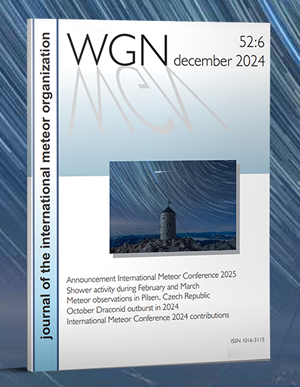August brings arguably the best meteor shower of the year – the Perseids. The large numbers of bright, colorful meteors, holidays and warm summer nights make this one of the best celestial shows of the year. Pack your gear, drive under dark skies and enjoy the spectacle!
The activity graph below is updated every 15 minutes – click for details.

What are the Perseids
The Perseids are one of the strongest annual meteor showers. As most other meteors, the Perseids are caused by small dust particles called meteoroids. Meteoroids usually originate from comets. As a comet revolves around the Sun it periodically heats up and ices on its surface begin to sublimate, releasing tiny mineral grains and clumps which were trapped in the ice. During tens to hundreds of successive revolutions around the Sun, a comet produces a long stream of meteoroids. If the Earth passes through this stream, meteoroids bombard our atmosphere, hitting it at tens of kilometers per second and creating beautiful streaks of light we know as meteors.
The Perseids are caused by the meteoroids from the periodic comet 109P/Swift-Tuttle, which revolves around the Sun every 130 years. The Perseids have been observed for centuries, but were officially recognized as a major meteor shower in the middle of the 19th century. They have been regularly observed for the past 150 years and are best known for a series of strong outbursts in the first half of the 1990s, which reached ZHRs up to about 500 meteors per hour.
Perseid meteoroids hit our atmosphere at 59 km/s, so the Perseids are swift meteors and often very colorful. Many brighter shower members leave persistent trains. Fireballs may leave persistent trains that last for tens of seconds or even minutes! Interestingly enough, the meteoroids that cause ordinary bright Perseids are only a few millimeters across! Even the meteoroids that produce fireballs are only centimeters across.
When can I observe the Perseids
The Perseids all appear to radiate from (fly out of) a point – the radiant – in the constellation of Perseus. The radiant drifts eastward each successive night. At the beginning of the shower’s activity it is located in the western part of Cassiopeia, drifting through it and into Perseus by early August and towards the border with Camelopardalis in late August. Check the radiant position before observation.

The first Perseids appear in mid July, but the shower begins picking up strength in the first week of August. By August 7 you may be able to see about 10 to 15 Perseids per hour just before dawn, if your sky is dark. By August 10 the rate increases to about 20-30 Perseids per hour. On the peak night, August 12/13, the rate will reach 80-100 meteors per hour! The numbers then decline by half every night, so the night after the peak you may see about 40-50 meteors per hour and on August 14/15 there will be about 25-30 Perseids per hour. The final Perseids may be seen around August 25. These rates are expected under dark skies – light pollution will diminish the number of meteors significantly.

But the rate also changes during the night. As the radiant rises, so does the number of meteors! The radiant is at its lowest during the evening hours and climbs high in the sky in the morning. The final hour before dawn will usually produce the most Perseids. So do persist until dawn!
Also remember that the Perseids are not the only active meteor shower in this period. Other active showers include the Kappa Cygnids, Southern delta Aquariids and Alpha Capricornids. Check the 2015 IMO Shower Calendar for more information.
How do I observe the Perseids?
To observe the Perseids, you need to dress warmly, bring a reclining chair and watch the sky. You need no other equipment. Find a dark observing spot, preferably with a low horizon and look in any (the darkest) direction.
Use this light pollution map to find dark locations near you.
But you can also contribute valuable observational data! If you decide to do so, use the IMO major meteor shower observing technique. This way your data will be in a standard format, that can readily be used for analysis. Send us your data as soon after the observations as possible.
Perseids 2015 in depth – predictions and expectations
The 2015 Perseids are expected to be above average. While their average annual ZHR is in the 80 – 100 range, some years are significantly better than that. With the Perseids an increase in activity is caused by one of the following two factors: 1) an encounter with a young dust trail or 2) a favourable gravitational perturbation by Jupiter and/or other planets, which shifts the center of the meteoroid stream earthwards.
Theoretical modelling by Jérémie Vaubaillon indicates a close encounter with the 1862 (1-rev) dust trail at only 0.00053 a.u. (80 000 km) from the Earth at 18h39m UT on August 12th (IMO Shower Calendar 2015). This is certainly a significantly close encounter, however, being 23 years behind the parent comet the activity levels are very uncertain. Any increase in activity caused by this encounter will last several hours centered on the peak time. In comparison, the same 1862 dust trail was also encountered in 2004, at 0.00132 a.u. distance. It caused a 2-hour outburst with peak ZHR ~200, dominated by faint meteors. That encounter, however, was only 12 years behind the parent comet.
In addition to the 1-rev dust trail encounter, it is highly likely that this year the overall activity of the Perseids will be somewhat elevated due to a favourable gravitational perturbation by Jupiter. The annual peak is expected on August 13 between 6h30m and 9h00m UT, however, variability found in the annual peak timing indicates the peak may occur any time between 1h30m and 14h00m UT on August 13. The maximum enhancement by this effect is expected in 2016 and 2017.
How to photograph the Perseids
Meteor photography is a lot of fun, particularly during a major meteor shower! Chances of photographing a bright meteor are really good. With modern cameras it is also really easy. You will need a photo tripod, a remote/programmable release and a suitable camera. With modern cameras the selection has expanded from DSLRs also to mirrorless and other types of cameras. The only requirements are: good performance at medium to high ISO (>800-1600), a reasonably fast and wide field lens (f/3.5 or faster is preferable). Put the camera on the tripod and aim it at the sky – it does not matter which part, meteors appear everywhere. Set the exposure to at least 15 sec, but you can go up to several minutes if the sky is dark or if the lens is slow or if you are using comparatively low ISO. Continue making successive photos throughout the night. On the peak night you are bound to catch some good meteors!
Expect an 18-mm lens at f/3.5 and ISO 1600 to detect meteors down to about magnitude 0, while a 50-mm lens at f/1.4 and ISO 3200 may detect meteors down to magnitude +3 or even +4. Of course to look really good on a photo the meteor must be at least two or three magnitudes brighter.
A final piece of advice to always keep in mind: properly focus the lens – check your focus every once in a while. There is no worse feeling than getting an out of focus shot of a beautiful meteor! Also bring backup batteries.








 You saw something bright and fast? Like a huge shooting star? Report it: it may be a fireball.
You saw something bright and fast? Like a huge shooting star? Report it: it may be a fireball.  You counted meteors last night? Share your results with us!
You counted meteors last night? Share your results with us!  You took a photo of a meteor or fireball? You have a screenshot of your cam? Share it with us!
You took a photo of a meteor or fireball? You have a screenshot of your cam? Share it with us!  You caught a meteor or fireball on video? Share your video with us!
You caught a meteor or fireball on video? Share your video with us!